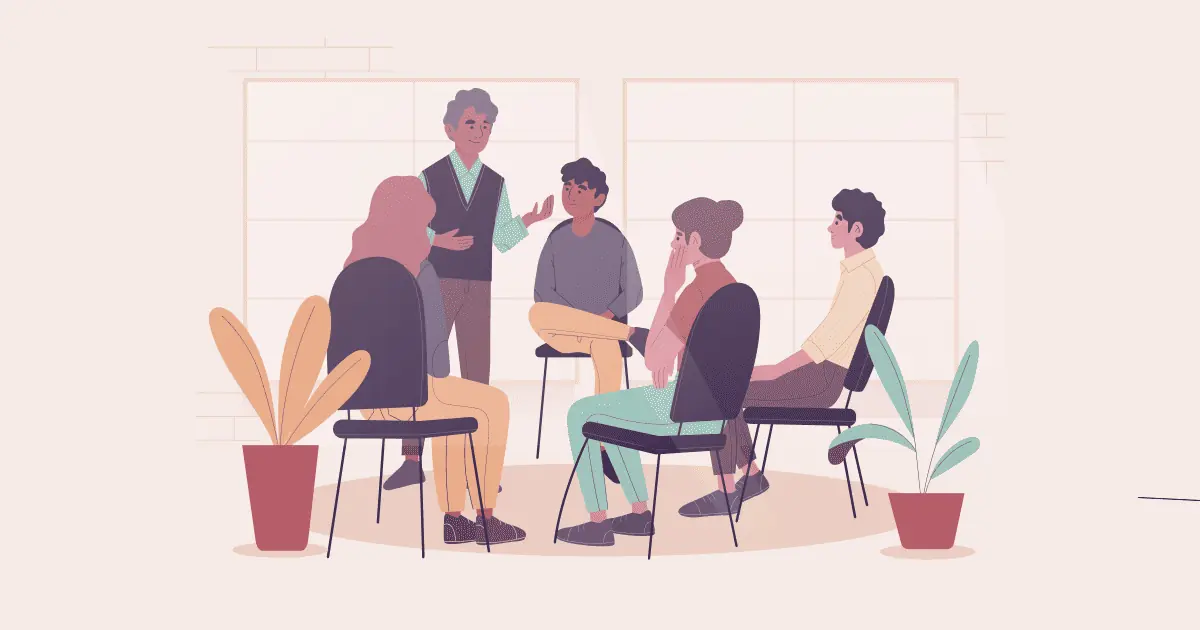Vad din kroppsspråk under presentationen säger om dig? Att göra och inte göra! Låt oss lära oss de bästa tipsen med AhaSlides!
Så, vilken är den bästa presentationsställningen? Har du obekvämt handsyndrom? Det har du förmodligen inte, för jag hittade just på det. Men – vi har alla stunder när vi inte vet vad vi ska göra med våra händer, ben eller någon annan del av vår kropp.
Du kan ha en fantastisk isbrytare, oklanderligt introduktionoch utmärkt presentation, men det är framförandet som spelar mest roll. Du vet inte vad du ska göra med dig själv, och det är perfekt normala.
Översikt
| Vad är pinans kroppsspråk? | nedåtgående blick, leendekontroller, bortvända huvudrörelser och ansiktsrörelser |
| Vilka är de icke-verbala tecknen på skam? | Sänkta axlar, sänkt huvud, nerblicken, ingen ögonkontakt, okonsekvent tal |
| Kan publiken märka när presentatörer är blyga? | Ja |
| Varför var Steve Jobs presentation så bra? | Han övade bara massor, tillsammans med att testa intresset. presentationskläder |

Tips för bättre engagemang
- Personlighet i en presentation
- Hur uttrycker du dig själv?
- Använda levande ordmoln or live Q&A till undersöka din publik lättare!
- Använda brainstorming verktyg effektivt av AhaSlides idétavla

Börja på några sekunder.
Få gratis mallar för din nästa interaktiva presentation. Registrera dig gratis och ta det du vill ha från mallbiblioteket!
🚀 Få mallar gratis
I vilken utsträckning vet du vad en lyckad presentation är? Förutom väl utformade PowerPoint-mallar är det viktigt att använda andra färdigheter i framförandet, särskilt kroppsspråk.
Nu när du vet att kroppsspråk är en oersättlig del av presentationsteknik, är det fortfarande långt ifrån att bemästra dessa färdigheter för att leverera effektiva presentationer.
Den här artikeln ger dig en helhetsbild av kroppsspråk och hur du kan dra nytta av dessa färdigheter för dina perfekta presentationer.
Innehållsförteckning
- Översikt
- Tips för bättre engagemang
- Kroppsspråkets betydelse under en presentation
- 10 tips för att bemästra kroppsspråk i presentationer
- 4 tips för kroppsgester
- Vanliga frågor
Kroppsspråkets betydelse för presentationer
När det gäller kommunikation med kroppsspråk nämner vi verbala och icke-verbala termer. Det är viktigt att komma ihåg att dessa termer har ett relativt samband. Vad är det egentligen?
Verbal kommunikation är att använda ord för att dela information med andra människor, både talat och skrivet. Till exempel ordet ”hur går det” som du väljer för att låta andra förstå vad du försöker säga till dem.
Icke-verbal kommunikation är överföring av information genom kroppsspråk, ansiktsuttryck, gester, skapat utrymme och mer. Att le när man möter någon förmedlar till exempel vänlighet, acceptans och öppenhet.
Oavsett om du är medveten om det eller inte, när du interagerar med andra, ger och tar du ständigt emot ordlösa signaler förutom att prata. Alla dina icke-verbala beteenden – din hållning, din intonation, de gester du gör och hur mycket ögonkontakt du har – förmedlar viktiga budskap.
De kan särskilt få människor att känna sig lugna, bygga förtroende och dra till sig uppmärksamhet, eller så kan de förolämpa och förvirra det du försöker uttrycka. Dessa budskap upphör inte heller när du slutar tala. Även när du är tyst kommunicerar du fortfarande icke-verbalt.
På samma sätt är en presentation också ett sätt att kommunicera med din publik; när du talar om din idé, visa kroppsspråk för att betona den. Att förstå vikten av både icke-verbala och verbala kommunikationsfärdigheter samtidigt kommer att hjälpa dig att undvika tråkiga presentationer.
För att göra det mycket enklare utforskar vi delar av kroppsspråk, en del av icke-verbal kommunikation. Kroppsspråk omfattar gester, ställningar och ansiktsuttryck. När du presenterar blir ett robust och positivt kroppsspråk ett kraftfullt instrument för att bygga trovärdighet, uttrycka dina känslor och få kontakt med dina lyssnare. Det hjälper också dina lyssnare att koncentrera sig mer på dig och ditt tal. Här ger vi dig 10+ exempel på kroppsspråk och tips för att utnyttja dina...
10 tips för att bemästra kroppsspråk i presentationer
Tänk på ditt utseende
För det första är det viktigt att ha ett snyggt utseende under presentationer. Beroende på vilket tillfälle kan du behöva förbereda lämplig outfit och välskött hår för att visa din professionalism och respekt för dina lyssnare.
Tänk på evenemangets typ och stil; de kan ha en strikt klädkod. Välj en outfit där du är mycket mer benägen att känna dig redo och självsäker inför publiken. Undvik färger, tillbehör eller smycken som kan distrahera publiken, göra oväsen eller orsaka bländning under scenljus.
Le, och le igen
Glöm inte att "le med ögonen" istället för bara munnen när du ler. Det skulle hjälpa att få andra att känna din värme och uppriktighet. Kom ihåg att behålla leendet även efter ett möte – i falska lyckomöten; du kan ofta se ett "på-av"-leende som blinkar och sedan försvinner snabbt efter att två personer gått åtskilda riktningar.
Öppna dina handflator
När du gestikulerar med händerna, se till att dina händer är öppna för det mesta och att folk kan se dina öppna handflator. Det är också en bra idé att hålla handflatorna vända för det mesta uppåt snarare än nedåt.
Få ögonkontakt
Det är vanligtvis en dålig idé att få ögonkontakt med enskilda medlemmar av din publik! Det är nödvändigt att hitta en sweet spot "tillräckligt länge" för att titta på dina lyssnare utan att vara stötande eller läskig. Ge det ett försök att titta på andra i cirka 2 sekunder för att minska tafatthet och nervositet. Titta inte på dina anteckningar för att skapa fler kontakter med dina lyssnare.
Kolla in tipsen på Ögonkontakt i kommunikation
Handklämmande
Du kanske tycker att dessa gester är användbara när du vill avsluta ett möte eller avsluta en interaktion med någon. Om du vill verka självsäker kan du använda den här signalen med tummarna utstickade – detta signalerar självförtroende istället för stress.
Blading
Bland nära vänner och andra man litar på är det skönt att slappna av med händerna i fickorna då och då. Men om du vill få den andra att känna sig osäker är det ett säkert sätt att stoppa händerna djupt i fickorna!
Rörande öra
Att röra vid örat eller en självlugnande gest sker undermedvetet när en person är orolig. Men vet du att det är en bra hjälp när du stöter på svåra frågor från publiken? Att röra vid örat när du tänker på lösningar kan göra din totala hållning mer naturlig.
Peka inte med fingret
Vad du än gör, peka inte. Se bara till att du aldrig gör det. Att peka finger medan man pratar är tabu i många kulturer, inte bara i presentationer. Människor upplever det alltid som aggressivt och obekvämt, stötande på något sätt.
Styr din röst
Tala långsamt och tydligt i alla presentationer. När du vill understryka huvudpunkterna kan du tala ännu långsammare och upprepa dem. Intonation är nödvändig; låt din röst höjas och sänkas för att låta naturlig. Säg ibland ingenting på ett tag för att få bättre kommunikation.
Gå runt
Att röra sig eller stanna på ett ställe när du presenterar är okej. Men överanvänd det inte; undvik att gå fram och tillbaka hela tiden. Gå när du tänker engagera publiken eller medan du berättar en rolig historia, eller medan publiken skrattar.
4 tips för kroppsgester
I den här artikeln kommer vi att ge några snabba tips om kroppsspråk och hur du kan utveckla dina presentationsfärdigheter gällande:
- Ögonkontakt
- Händer och axlar
- arv
- Bak huvud
Ditt kroppsspråk är avgörande eftersom det inte bara gör dig se mer självsäker, självsäker och samlad, men du kommer också att hamna känsla dessa saker. Du bör också undvika att titta ner när du pratar.
Ögon – Kroppsspråk under presentation
Gör inte Undvik ögonkontakt som om det vore pesten. Många vet inte hur man får ögonkontakt och lär sig att stirra på bakväggen eller någons panna. Folk märker när du inte tittar på dem och kommer att uppfatta dig som nervös och avlägsen. Jag var en av de presentatörerna eftersom jag trodde att det att tala inför publik var samma sak som att skådespela. När jag gjorde teaterproduktioner på gymnasiet uppmuntrade de oss att titta på bakväggen och inte engagera oss med publiken eftersom det skulle ta dem ur den fantasivärld vi skapade. Jag lärde mig den hårda vägen att skådespeleri inte är samma sak som att tala inför publik. Det finns liknande aspekter, men man vill inte blockera publiken från sin presentation – man vill inkludera dem, så varför skulle man låtsas som att de inte är där?
Å andra sidan lär vissa människor att titta på bara en person som också är en dålig vana. Att stirra på en individ hela tiden kommer att göra dem väldigt obekväma och den atmosfären kommer också att distrahera de andra publiken.

DO Få kontakt med människor som du skulle göra med ett vanligt samtal. Hur förväntar du dig att folk ska vilja interagera med dig om de inte känner sig sedda? En av de mest användbara presentationsteknikerna jag har lärt mig av Nicole Dieker är att folk älskar uppmärksamhet! Ta dig tid att få kontakt med din publik. När människor känner att en programledare bryr sig om dem känner de sig viktiga och uppmuntrade att dela med sig av sina känslor. Flytta ditt fokus till olika publikmedlemmar för att främja en inkluderande miljö. Särskilt engagera dig med dem som redan tittar på dig. Inget är värre än att stirra ner på någon som tittar på sin telefon eller sitt program.
Använd så mycket ögonkontakt som du skulle göra när du pratar med en vän. Allmänheten är densamma, bara i större skala och med fler människor.
händer– Kroppsspråk under presentationen
Begränsa dig inte eller övertänk det. Det finns så många sätt att hålla händerna på ett felaktigt sätt, som bakom ryggen (som blir aggressiv och formell), under bältet (begränsar rörelserna) eller stelt vid sidorna (vilket känns obekvämt). Korsa inte armarna; detta framstår som defensivt och distanserat. Viktigast av allt, gestera inte för mycket! Detta kommer inte bara att bli ansträngande, utan publiken kommer att börja fixera sig vid hur trött du måste vara snarare än innehållet i din presentation. Gör din presentation lätt att se och därför lätt att förstå.

DO Vila händerna i en neutral position. Detta kommer att vara strax ovanför naveln. Den mest framgångsrika neutrala positionen är antingen att hålla en hand i den andra eller helt enkelt röra vid dem på det sätt dina händer naturligt skulle göra. Händer, armar och axlar är den viktigaste visuella signalen för publiken. Du skall gest som ditt typiska kroppsspråk i en vanlig konversation. Var inte en robot!
Nedan följer en snabb video av Steve Bavister, och jag rekommenderar att du tittar på den för att visualisera vad jag just beskrivit.
arv– Kroppsspråk under presentationen
Gör inte lås benen och stå still. Det är inte bara farligt, utan det får dig också att se obekväm ut (gör publiken obekväm). Och ingen gillar att känna sig obekväm! Blodet börjar samlas i dina ben och utan rörelse kommer blodet att ha svårt att återcirkulera till hjärtat. Detta gör dig mottaglig för att svimma, vilket definitivt skulle vara ... du gissade rätt ... obekväm. Tvärtom, rör inte på benen för mycket. Jag har varit på några presentationer där talaren gungar fram och tillbaka, fram och tillbaka, och jag ägnade så mycket uppmärksamhet åt detta distraherande beteende att jag glömde vad han pratade om!

DO Använd dina ben som en förlängning av dina handgester. Ta ett steg framåt om du vill göra ett uttalande som berör din publik. Ta ett steg tillbaka om du vill ge utrymme för tankar efter en häpnadsväckande idé. Det finns en balans i allt. Tänk på scenen som ett enda plan – du ska inte vända publiken ryggen. Gå på ett sätt som inkluderar alla människor i rummet och rör dig runt så att du kan synas från varje plats.
Rygg– Kroppsspråk under presentationen
Gör inte vika in dig själv med sjunkna axlar, hängande huvud och böjd nacke. Människor har undermedvetna fördomar mot denna form av kroppsspråk och kommer att börja ifrågasätta din förmåga som presentatör om du framstår som en defensiv, självmedveten och osäker talare. Även om du inte identifierar dig med dessa beskrivningar kommer din kropp att visa det.

DO övertyga dem om ditt förtroende med din hållning. Stå rakt som ditt huvud är anslutet till en lärad sträng fäst vid taket. Om ditt kroppsspråk skildrar förtroende kommer du att bli säker. Du kommer att bli förvånad över hur lite justeringar som kommer att förbättra eller förvärra din talleverans. Prova att använda dessa presentationsfärdigheter i spegeln och se själv!
Slutligen, om du har förtroende för din presentation kommer ditt kroppsspråk att förbättras drastiskt. Din kropp kommer att spegla hur stolt du är över dina bilder och din beredskap. AhaSlides är ett bra verktyg att använda om du vill bli en mer självsäker presentatör och imponera på din publik med interaktiva verktyg i realtid som de kan använda medan du presenterar. Bästa delen? Det är gratis!
Slutsats
Så, vad säger kroppsspråket under presentationen om dig? Låt oss ta del av våra tips och fundera över hur du kan införliva dem i din presentation. Tveka inte att öva framför spegeln hemma eller med en bekant publik och be om feedback. Övning gör färdighet. Du kommer att kunna bemästra ditt kroppsspråk och få positiva resultat av din presentation..
Extra tipsFör en virtuell onlinepresentation eller när du bär mask kan du stöta på svårigheter med att visa kroppsspråk. Du kan överväga att använda din presentationsmall för att fånga publikens uppmärksamhet. 100+ AhaSlides-typer av presentationsmallar.
Vanliga frågor
Vad man ska göra med händerna när man presenterar
När du presenterar är det viktigt att använda händerna målmedvetet för att göra ett positivt intryck och förstärka ditt budskap. Därför bör du hålla händerna avslappnade med öppna handflator, använda gester som gynnar din presentation och upprätthålla ögonkontakt med din publik.
När jag presenterar för en neutral publik, varför ska jag presentera båda sidor av saken?
Att presentera båda sidor av en sak för en neutral publik är viktigt, eftersom det hjälper många att engagera sig med publiken, stärker ditt kritiska tänkande, gör din presentation bättre och bidrar även till att öka trovärdigheten.
Vilken typ av gester bör undvikas i ett tal?
Du bör undvika distraktionsgester, som: att tala dramatiskt men inte relevant för ditt innehåll; vibrerande som att knacka med fingrarna eller leka med föremål; pekande fingrar (som visar respektlöshet); korsande armar och överraskande och alltför formella gester!






